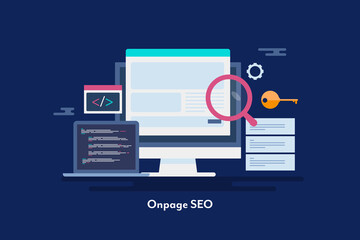SEO is one of the most popular digital marketing strategies and for good reason. It’s relatively inexpensive and offers a high ROI. The most common on-page SEO elements include title tags, content, and internal links. However, it’s important to remember that SEO isn’t a one-and-done effort. Visit Website to learn more.

Title tags are the first thing search engines see when they run a query. They should be unique, concise, and relevant to the search query.
Keywords
The words and phrases that people type into search engines to find your business are called keywords. Digital marketers use them to optimize their website and content so that it shows up when someone searches for those terms. They also help determine what kind of traffic you will get from those searches.
Search engine algorithms take multiple factors into account when ranking websites, but on-page SEO is one of the most important. It includes keyword research, optimizing title tags and meta descriptions, and ensuring that your website content is relevant to what users are looking for.
Ideally, you want to target keywords that have a high search volume and low competition. This will ensure that you get a lot of traffic and visibility without spending a lot of money. But it’s not always possible to target a single keyword, especially if you have a big website with lots of different products and services.
Keywords are a great way to narrow down your target audience. They can tell you how much they know about your product or service, what stage of the buyer’s journey they are at, and whether they are ready to buy. They also provide a way to track the performance of your marketing campaigns.
When selecting keywords, it’s important to keep in mind that they should be natural and reflect your audience’s real-life conversations. This will help you rank higher on search engines and drive more qualified leads. To avoid overusing keywords, try to limit your keyword usage to 5% of the total word count of the page. This is called keyword density, and it can be determined by using a tool like Moz’s Keyword Explorer.
Another key on-page SEO strategy is to include your keywords in the headline and text of your web pages. This will make it easier for Google to understand the relevance of your content and rank it accordingly. You can also optimize your title tags and meta descriptions to add more information about the topics that are covered in your pages.
Finally, it’s important to use your keyword in the URL of your site and its social media profiles. This will increase your chances of getting featured snippets, which are the highlighted search results that show up in the Google search bar.
Meta tags
Meta tags are not only important for SEO, but they’re also a great way to help search engines and users find the information they need on your site. Title and meta descriptions are snippets of HTML that describe your page’s content, and they play a huge role in how people interact with your website.
A well-written meta tag can help improve your click-through rate in search results, and it can also make the difference between someone clicking on your page or another one. This is especially true for mobile searches, where the meta description can make or break whether a user decides to click on your result.
The meta title and meta description tags are the first things that search engines see, so they’re an important part of any SEO strategy. These tags indicate to both robots and users what your page is about, so it’s important to keep them unique and relevant. It’s also important to use your primary keyword in the meta description, but don’t overdo it; you don’t want to put your keywords in a way that makes it look spammy.
Adding a meta description can boost your click-through rates and increase the number of visitors to your site, so it’s an essential part of any on-page SEO strategy. It is also a good idea to include a call-to-action (CTA) in your meta description, which will encourage users to take the next step. This could be something as simple as a ‘buy now’ for a product, or a ‘read more’ button for a blog post.
Other meta tags can be used to enhance the user experience and improve the display of your content. For example, the image alt text tag is a way to make your website more accessible for visually impaired users. Similarly, the viewport tag tells search engines how your web page should be displayed on mobile devices.
However, not all meta tags are created equal. Some are unnecessary and can even harm your rankings if overused. To avoid these issues, you should keep your head> section as clean as possible by eliminating any meta tags that aren’t necessary for your site.
On-page optimization
On-page optimization is the process of improving individual pages on your website to improve their rankings in search engine results. This includes optimizing meta tags, titles, and content. It is an important part of any digital marketing strategy because it allows you to target specific keywords and get the most out of your search engine optimization budget. In addition, it ensures that your website is visible to the right people and increases your conversion rate.
On page optimization is a continuous process that must be adapted to new SEO algorithms and user intent. It also requires an understanding of the keywords that you are targeting and the ways in which users search for those keywords. This is why it’s so important to work with a trusted and experienced SEO agency.
Title tags and meta descriptions are arguably the most important on-page SEO elements. These are HTML tags that help search engines and users understand what a page is about. A well-written title tag and meta description can increase click-through rates in search results, which in turn leads to more traffic and better organic rankings. However, it’s important to avoid keyword stuffing, which can be detrimental to SEO and may make your site feel spammy to users.
Other on-page SEO factors include keyword variations in the URL and alt text for images. The latter is especially important because Google uses this information to determine the relevance of a page and deliver relevant search results. In addition, it can increase your search engine ranking when the image is optimized for relevant queries.
While on-page optimization is a critical element of search engine optimization, it’s important to remember that the most important factor is high-quality content. If your content is not useful to users, no amount of on-page optimization will help it rank well. To achieve this, you must create content that addresses the needs and concerns of your audience. This will allow you to create content that is both engaging and informative for your customers. In addition, you should focus on promoting your content via social media and paid advertising.
Link building
If you’re looking for ways to increase the amount of organic traffic to your website, link building is a great place to start. In the world of search engine optimization, a page is deemed more authoritative if it has lots of links. This is because it suggests that other websites find the content valuable and want to share it with their visitors. In addition to improving your search engine rankings, linking to other pages on your website also helps improve your brand image and establishes you as an expert in your industry.
You should include internal links in all of your content. This will help reduce your bounce rate and improve other Google Analytics metrics like average session duration and conversions. In addition to that, internal links will help search engines crawl your site more thoroughly and understand what each page is about. To create good internal links, use short, descriptive, keyword-focused anchor text. You should also try to avoid using generic phrases like “click here” or “more information.”
In addition to link building, you can also promote your content on social media. However, don’t forget to target the right keywords. This will ensure that your content reaches the people who are most interested in it. Also, make sure your content is relevant and useful to the audience you’re targeting. Otherwise, it’s unlikely that anyone will share your content with their friends or family members.
Creating content that answers questions and solves problems is one of the best ways to attract links. This content is usually very popular and can quickly rise to the top of Google search results. It can also become a featured snippet, which increases the likelihood of it being clicked by users. Featured snippets are displayed in the search results for queries with very specific intent, which makes them more likely to be clicked than general search results.
You can build your online reputation by promoting your content on social media, creating guest posts for reputable blogs and websites, and participating in forums. However, remember that not all forms of link building are created equal. You should only focus on link building techniques that are considered to be legitimate and ethical by Google.
